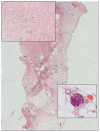Metal deposition in calcific uremic arteriolopathy
- PMID: 19406504
- PMCID: PMC3622256
- DOI: 10.1016/j.jaad.2009.01.042
Metal deposition in calcific uremic arteriolopathy
Abstract
Background: Calcific uremic arteriolopathy (CUA) is an often fatal disease that affects patients with end-stage renal disease. Although animal studies support a role for metals in the pathogenesis of CUA, metal accumulation in human tissue has not been previously evaluated.
Objective: We sought to evaluate metal deposition in CUA.
Methods: Twelve histologically proven cases of CUA were identified from our dermatopathology database. Five skin biopsy specimens from patients with chronic kidney disease exposed to gadolinium contrast but without CUA were used as controls. Quantification of metals including iron, aluminum, and gadolinium in the lesional skin was performed using inductively coupled mass spectrometry.
Results: Seven patients had documented exposure to gadolinium-based contrast in the 2 years before CUA. Three of them had concurrent nephrogenic systemic fibrosis. Highly significant quantities of iron (P = .03) and aluminum (P = .0002) were detected in CUA specimens compared with controls. Significant amounts of gadolinium were present in several CUA biopsy specimens.
Limitations: Observational, retrospective study design and small sample size are limitations.
Conclusion: Tissue iron and aluminum content is increased in CUA. A significant amount of gadolinium is also present in some CUA specimens. Based on animal studies that strongly implicate metals in the pathogenesis of CUA, our data suggest that metal deposition should be considered in the pathogenesis of human CUA.
Figures


Similar articles
-
Localization, Morphologic Features, and Chemical Composition of Calciphylaxis-Related Skin Deposits in Patients With Calcific Uremic Arteriolopathy.JAMA Dermatol. 2019 Jul 1;155(7):789-796. doi: 10.1001/jamadermatol.2019.0381. JAMA Dermatol. 2019. PMID: 31116362 Free PMC article.
-
Calciphylaxis in the current era: emerging 'ironic' features?Nephrol Dial Transplant. 2011 Jan;26(1):191-5. doi: 10.1093/ndt/gfq407. Epub 2010 Jul 12. Nephrol Dial Transplant. 2011. PMID: 20627865
-
Novel insights into osteogenesis and matrix remodelling associated with calcific uraemic arteriolopathy.Nephrol Dial Transplant. 2013 Apr;28(4):856-68. doi: 10.1093/ndt/gfs466. Epub 2012 Dec 6. Nephrol Dial Transplant. 2013. PMID: 23223222
-
Multidisciplinary approach to calcific uremic arteriolopathy.Curr Opin Nephrol Hypertens. 2015 Nov;24(6):531-7. doi: 10.1097/MNH.0000000000000175. Curr Opin Nephrol Hypertens. 2015. PMID: 26371529 Review.
-
Nephrogenic fibrosing dermopathy/nephrogenic systemic fibrosis.Nephrol Nurs J. 2007 May-Jun;34(3):283-7; quiz 288. Nephrol Nurs J. 2007. PMID: 17644872 Review.
Cited by
-
Achieving Effective Multimodal Imaging with Rare-Earth Ion-Doped CaF2 Nanoparticles.Pharmaceutics. 2022 Apr 11;14(4):840. doi: 10.3390/pharmaceutics14040840. Pharmaceutics. 2022. PMID: 35456674 Free PMC article.
-
Synthesis of Multicolor Core/Shell NaLuF₄:Yb3+/Ln3+@CaF₂ Upconversion Nanocrystals.Nanomaterials (Basel). 2017 Feb 7;7(2):34. doi: 10.3390/nano7020034. Nanomaterials (Basel). 2017. PMID: 28336867 Free PMC article.
-
Calcific Uremic Arteriolopathy: A Case Series and Review from an Inner-City Tertiary University Center in End-Stage Renal Disease Patients on Renal Replacement Therapy.Int J Nephrol. 2021 Feb 12;2021:6661042. doi: 10.1155/2021/6661042. eCollection 2021. Int J Nephrol. 2021. PMID: 33628505 Free PMC article.
-
Analysis of liver iron concentration in an elderly female undergoing hemodialysis with calcific uremic arteriolopathy does not support the role of iron overload in calciphylaxis: lesson for the clinical nephrologist.J Nephrol. 2021 Oct;34(5):1547-1551. doi: 10.1007/s40620-020-00904-z. Epub 2021 Jan 23. J Nephrol. 2021. PMID: 33484427 Free PMC article. No abstract available.
-
Gadolinium contrast agent-induced CD163+ ferroportin+ osteogenic cells in nephrogenic systemic fibrosis.Am J Pathol. 2013 Sep;183(3):796-807. doi: 10.1016/j.ajpath.2013.06.008. Epub 2013 Jul 16. Am J Pathol. 2013. PMID: 23867799 Free PMC article.
References
-
- Bleyer A, Choi M, Igwemezie B, de la Torre E, White WL. A case control study of proximal calciphylaxis. Am J Kidney Dis. 1998;32:376–383. - PubMed
-
- Coates T, Kirkland GS, Dymock RB, Murphy BF, Brealey JK, Mathew TH, et al. Cutaneous necrosis from calcific uremic arteriolopathy. Am J Kidney Dis. 1998;32:384–391. - PubMed
-
- Lewis KG, Robinson-Bostom L. Nephrogenic fibrosing dermopathy and calciphylaxis with pseudoxanthoma elasticum-like changes. J Cutan Pathol. 2006;33:695–700. - PubMed
-
- Fine A, Zacharias J. Calciphylaxis is usually non-ulcerating: risk factors, outcome and therapy. Kidney Int. 2002;61:2210–7. - PubMed
-
- Reed KB, Davis MD. The incidence of physician-diagnosed calciphylaxis: a population-based study. J Am Acad Dermatol. 2007;57:365–6. - PubMed
Publication types
MeSH terms
Substances
Grants and funding
LinkOut - more resources
Full Text Sources
Medical

